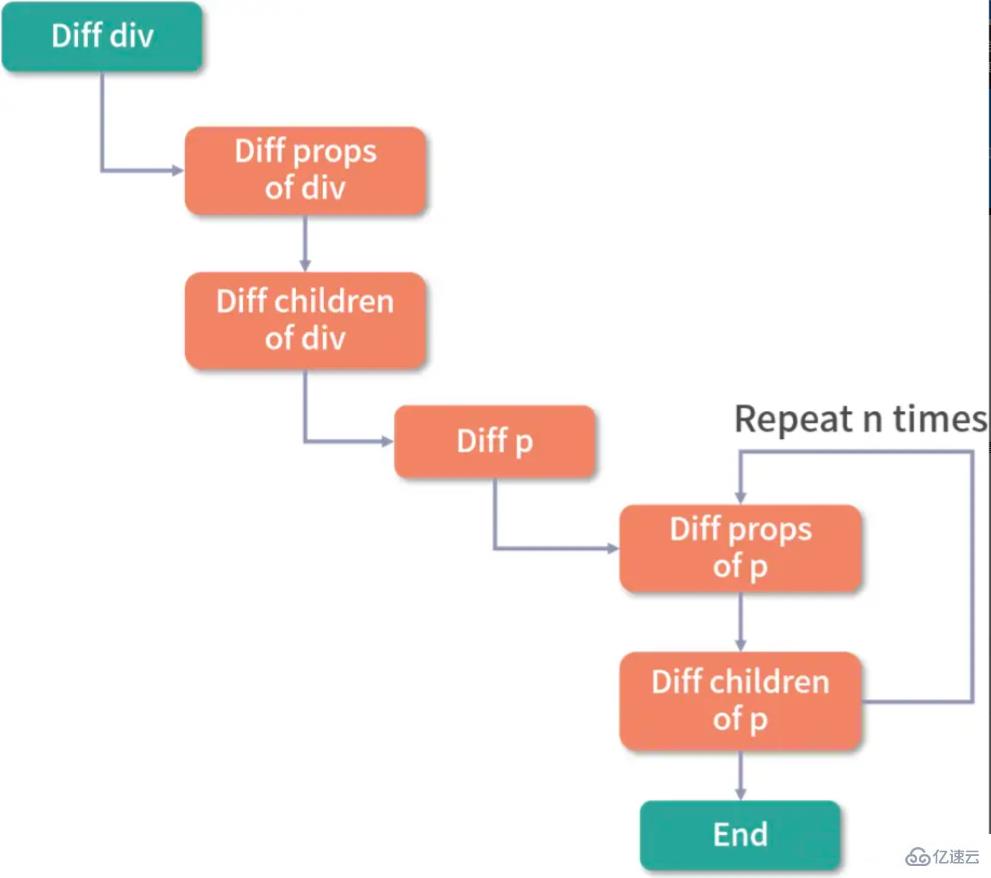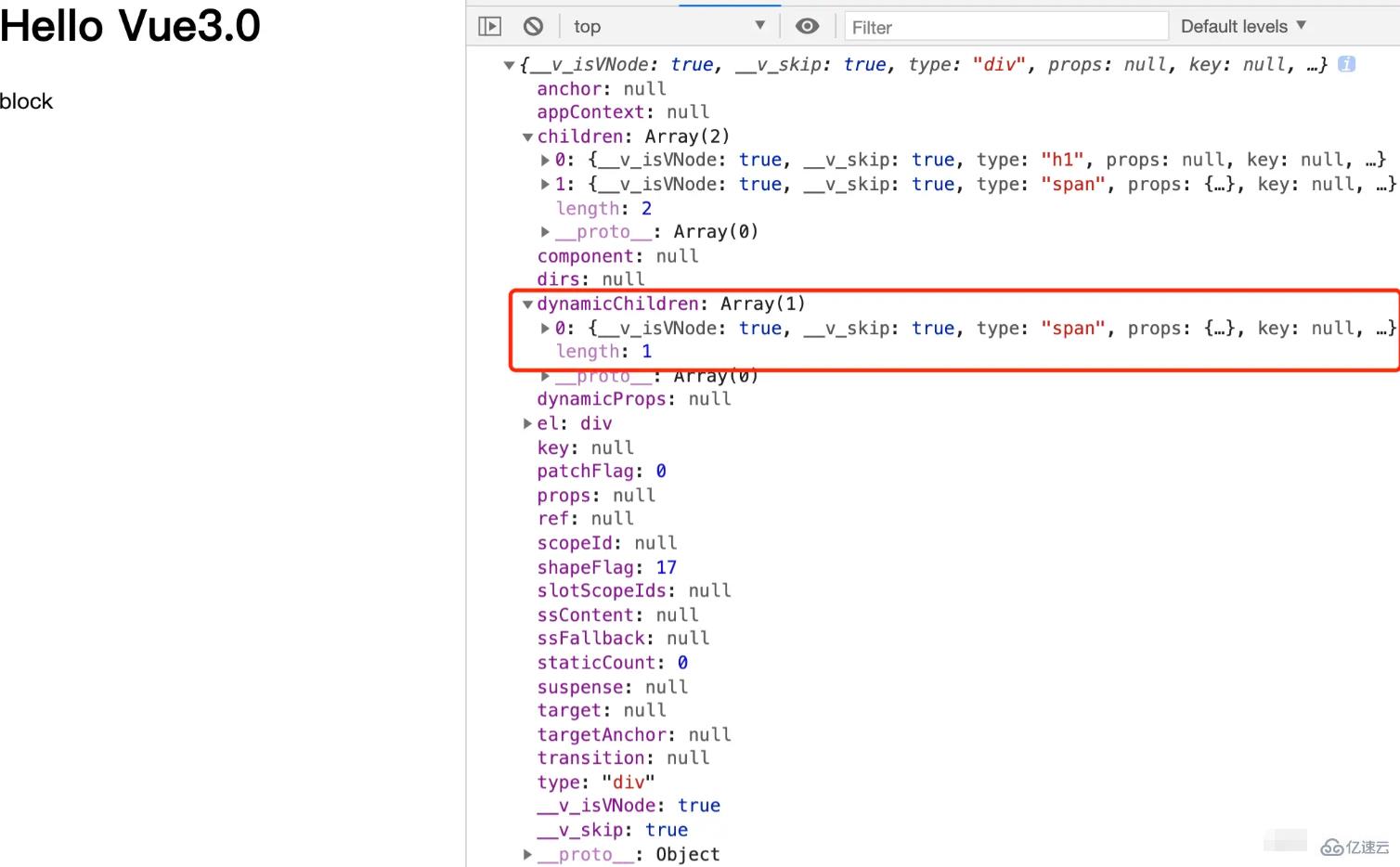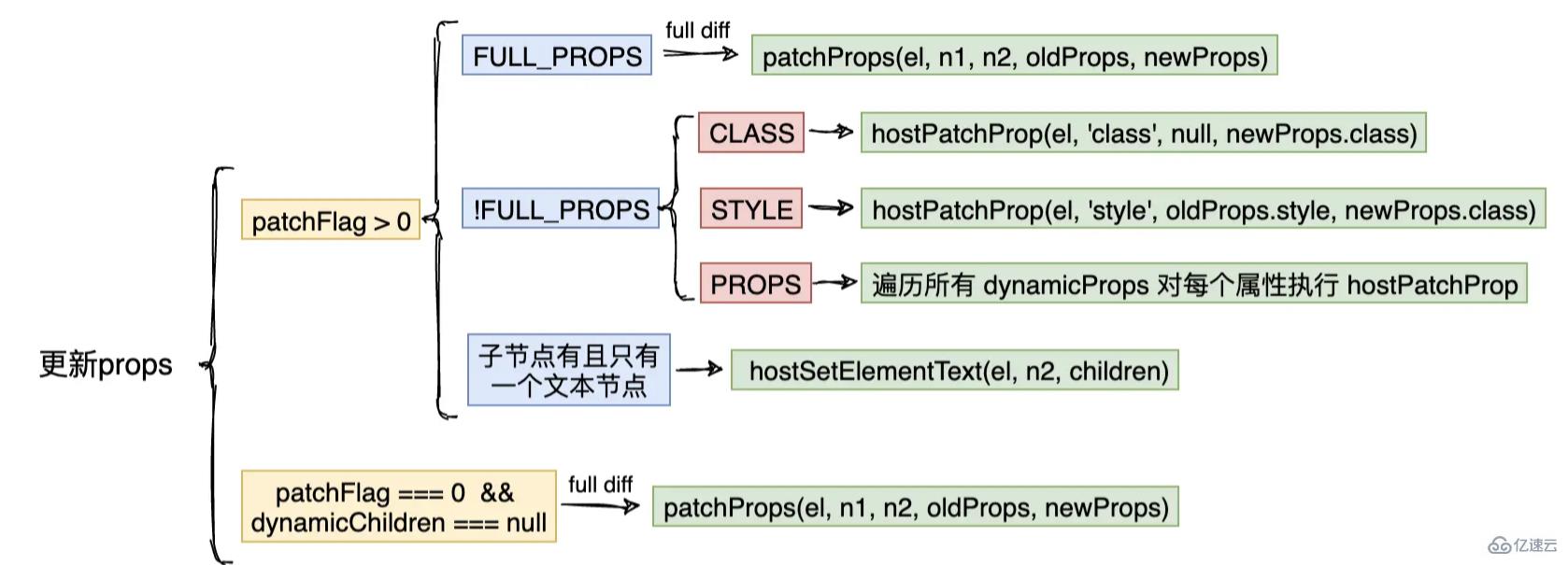ホームページ >ウェブフロントエンド >Vue.js >vue3のコンパイルと最適化の内容は何ですか?
vue3のコンパイルと最適化の内容は何ですか?
- 王林転載
- 2023-05-17 17:50:161494ブラウズ
vue3 コンパイルの最適化には次のものが含まれます: 1. 動的コンテンツをマークするための patchFlag の導入; コンパイル プロセス中に、異なる属性タイプに従って異なるラベルがマークされるため、高速 diff アルゴリズムが実現します。 2. ブロックツリー。 3. 静的プロモーションとは、静的なノードまたは属性をプロモートすることです。連続して 10 個を超える静的ノードがある場合、前処理は文字列化され、静的ノードの連続シーケンスにマージされます。 cacheHandlers オプションが有効になっている場合、関数はキャッシュされるため、後で直接呼び出すことができます。
この記事では、主に Vue3.0 コンパイル段階で行われる最適化と、これらの最適化戦略を使用して パッチ# での比較の数を減らす方法を分析します。 ##ステージ。
コンポーネントが更新されるときは、次のテンプレートのようにコンポーネントの vnode ツリー全体をトラバースする必要があるため、
<template>
<div id="container">
<p class="text">static text</p>
<p class="text">static text</p>
<p class="text">{{ message }}</p>
<p class="text">static text</p>
<p class="text">static text</p>
</div>
</template>全体の差分プロセスは図に示すとおりです。
 ##ご覧のとおり、このコードには動的ノードが 1 つしかないため、実際には不必要な差分と走査が多数あります。これにより、
##ご覧のとおり、このコードには動的ノードが 1 つしかないため、実際には不必要な差分と走査が多数あります。これにより、
とは関係ありません。一部のコンポーネントのテンプレート全体に動的ノードが少数しかない場合、これらは走査はパフォーマンスの無駄です。上記の例では、理想的には、バインドされたメッセージの動的ノードの p タグを比較するだけで済みます。
Vue.js 3.0 コンパイル段階での静的テンプレートの分析を通じて、ブロック ツリーがコンパイルおよび生成されます。
は、動的ノード命令に基づいてテンプレートを切り取るネストされたブロックです。各ブロック内のノード構造は固定されており、各ブロックには Array が 1 つだけ必要です。それ自体に含まれる動的ノードを追跡します。 ブロック ツリーの助けを借りて、Vue.js は、vnode 更新のパフォーマンスを、テンプレート全体のサイズに関連するものから、動的コンテンツの量に関連するものに改善しました。これは、非常に大きなパフォーマンスのブレークスルーです。 。 PatchFlag
diff
アルゴリズムでは、新旧の仮想DOM での無駄な比較操作を回避できないため、Vue.js 3.0 では、動的コンテンツをマークするための patchFlag が導入されました。コンパイル プロセス中に、さまざまな属性タイプに応じてさまざまな識別子がマークされるため、高速な diff アルゴリズムが実現します。 PatchFlags のすべての列挙型は次のとおりです:
export const enum PatchFlags {
TEXT = 1, // 动态文本节点
CLASS = 1 << 1, // 动态class
STYLE = 1 << 2, // 动态style
PROPS = 1 << 3, // 除了class、style动态属性
FULL_PROPS = 1 << 4, // 有key,需要完整diff
HYDRATE_EVENTS = 1 << 5, // 挂载过事件的
STABLE_FRAGMENT = 1 << 6, // 稳定序列,子节点顺序不会发生变化
KEYED_FRAGMENT = 1 << 7, // 子节点有key的fragment
UNKEYED_FRAGMENT = 1 << 8, // 子节点没有key的fragment
NEED_PATCH = 1 << 9, // 进行非props比较, ref比较
DYNAMIC_SLOTS = 1 << 10, // 动态插槽
DEV_ROOT_FRAGMENT = 1 << 11,
HOISTED = -1, // 表示静态节点,内容变化,不比较儿子
BAIL = -2 // 表示diff算法应该结束
} 左側 # #template コンパイル後、右側の
コンパイル後、右側の
関数が生成されます。これには、_openBlock、_createElementBlock、_toDisplayString が含まれます。 、 _createElementVNode(createVnode) およびその他の補助関数。 <pre class="brush:js;toolbar:false;">let currentBlock = null
function _openBlock() {
currentBlock = [] // 用一个数组来收集多个动态节点
}
function _createElementBlock(type, props, children, patchFlag) {
return setupBlock(createVnode(type, props, children, patchFlag));
}
export function createVnode(type, props, children = null, patchFlag = 0) {
const vnode = {
type,
props,
children,
el: null, // 虚拟节点上对应的真实节点,后续diff算法
key: props?.["key"],
__v_isVnode: true,
shapeFlag,
patchFlag
};
...
if (currentBlock && vnode.patchFlag > 0) {
currentBlock.push(vnode);
}
return vnode;
}
function setupBlock(vnode) {
vnode.dynamicChildren = currentBlock;
currentBlock = null;
return vnode;
}
function _toDisplayString(val) {
return isString(val)
? val
: val == null
? ""
: isObject(val)
? JSON.stringify(val)
: String(val);
}</pre>この時点で生成される vnode は次のとおりです:
dynamicChildren 属性がもう 1 つあります、動的ノード
属性がもう 1 つあります、動的ノード
を収集します。 ノード diff 最適化戦略:
以前に分析したところ、patch ステージでノード要素を更新すると、
patchElement# は次のようになります。 ## 関数を実行したので、その実装を確認してみましょう:const patchElement = (n1, n2) => { // 先复用节点、在比较属性、在比较儿子
let el = n2.el = n1.el;
let oldProps = n1.props || {}; // 对象
let newProps = n2.props || {}; // 对象
patchProps(oldProps, newProps, el);
if (n2.dynamicChildren) { // 只比较动态元素
patchBlockChildren(n1, n2);
} else {
patchChildren(n1, n2, el); // 全量 diff
}
} このプロセスはコンポーネント更新の前の章で分析しましたが、サブノードの更新部分を分析するときに、その時点では最適化シナリオを考慮していませんでした。私たちだけが完全な比較と更新のシナリオを分析しました。 実際、この vnode が Block vnode
である場合、patchChildren の完全な比較を渡す必要はありません。必要なのは、完全な比較だけです。 to passpatchBlockChildren Block 内の動的子ノードを比較して更新するだけです。
tree レベルの比較から線形構造の比較まで、パフォーマンスが大幅に向上していることがわかります。 その実装を見てみましょう:
const patchBlockChildren = (n1, n2) => {
for (let i = 0; i < n2.dynamicChildren.length; i++) {
patchElement(n1.dynamicChildren[i], n2.dynamicChildren[i])
}
}const patchElement = (n1, n2) => { // 先复用节点、在比较属性、在比较儿子
let el = n2.el = n1.el;
let oldProps = n1.props || {}; // 对象
let newProps = n2.props || {}; // 对象
let { patchFlag, dynamicChildren } = n2
if (patchFlag > 0) {
if (patchFlag & PatchFlags.FULL_PROPS) { // 对所 props 都进行比较更新
patchProps(el, n2, oldProps, newProps, ...)
} else {
// 存在动态 class 属性时
if (patchFlag & PatchFlags.CLASS) {
if (oldProps.class !== newProps.class) {
hostPatchProp(el, 'class', null, newProps.class, ...)
}
}
// 存在动态 style 属性时
if (patchFlag & PatchFlags.STYLE) {
hostPatchProp(el, 'style', oldProps.style, newProps.style, ...)
}
// 针对除了 style、class 的 props
if (patchFlag & PatchFlags.PROPS) {
const propsToUpdate = n2.dynamicProps!
for (let i = 0; i < propsToUpdate.length; i++) {
const key = propsToUpdate[i]
const prev = oldProps[key]
const next = newProps[key]
if (next !== prev) {
hostPatchProp(el, key, prev, next, ...)
}
}
}
if (patchFlag & PatchFlags.TEXT) { // 存在动态文本
if (n1.children !== n2.children) {
hostSetElementText(el, n2.children as string)
}
}
} else if (dynamicChildren == null) {
patchProps(el, n2, oldProps, newProps, ...)
}
}
}
function hostPatchProp(el, key, prevValue, nextValue) {
if (key === 'class') { // 更新 class
patchClass(el, nextValue)
} else if (key === 'style') { // 更新 style
patchStyle(el, prevValue, nextValue)
} else if (/^on[^a-z]/.test(key)) { // events addEventListener
patchEvent(el, key, nextValue);
} else { // 普通属性 el.setAttribute
patchAttr(el, key, nextValue);
}
}
function patchClass(el, nextValue) {
if (nextValue == null) {
el.removeAttribute('class'); // 如果不需要class直接移除
} else {
el.className = nextValue
}
}
function patchStyle(el, prevValue, nextValue = {}){
...
}
function patchAttr(el, key, nextValue){
...
}概要: vue3
は、最適化のために patchFlag
とdynamicChildren を最大限に活用します。 style の変更など、ローカルな変更のみがあると判断された場合は、hostPatchProp のみが呼び出され、対応するパラメータ style が渡されます。特定の更新を行うためのメソッド (Targeted update); dynamicChildren がある場合、patchBlockChildren が比較と更新のために実行され、 は実行されません。毎回、props と子ノードの完全な比較と更新。 #静的プロモーション
 静的プロモーションとは、静的なノードまたは属性をプロモートすることです。次のテンプレート:
静的プロモーションとは、静的なノードまたは属性をプロモートすることです。次のテンプレート:
<div>
<span>hello</span>
<span a=1 b=2>{{name}}</span>
<a><span>{{age}}</span></a>
</div>编译生成的 render 函数如下:
export function render(_ctx, _cache, $props, $setup, $data, $options) {
return (_openBlock(), _createElementBlock("div", null, [
_createElementVNode("span", null, "hello"),
_createElementVNode("span", {
a: "1",
b: "2"
}, _toDisplayString(_ctx.name), 1 /* TEXT */),
_createElementVNode("a", null, [
_createElementVNode("span", null, _toDisplayString(_ctx.age), 1 /* TEXT */)
])
]))
}我们把模板编译成 render 函数是这个酱紫的,那么问题就是每次调用 render 函数都要重新创建虚拟节点。
开启静态提升 hoistStatic 选项后
const _hoisted_1 = /*#__PURE__*/_createElementVNode("span", null, "hello", -1 /* HOISTED */)
const _hoisted_2 = {
a: "1",
b: "2"
}
export function render(_ctx, _cache, $props, $setup, $data, $options) {
return (_openBlock(), _createElementBlock("div", null, [
_hoisted_1,
_createElementVNode("span", _hoisted_2, _toDisplayString(_ctx.name), 1 /* TEXT */),
_createElementVNode("a", null, [
_createElementVNode("span", null, _toDisplayString(_ctx.age), 1 /* TEXT */)
])
]))
}预解析字符串化
静态提升的节点都是静态的,我们可以将提升出来的节点字符串化。 当连续静态节点超过 10 个时,会将静态节点序列化为字符串。
假如有如下模板:
<div> <span>static</span> <span>static</span> <span>static</span> <span>static</span> <span>static</span> <span>static</span> <span>static</span> <span>static</span> <span>static</span> <span>static</span> </div>
开启静态提升 hoistStatic 选项后
const _hoisted_1 = /*#__PURE__*/_createStaticVNode("<span>static</span><span>static</span><span>static</span><span>static</span><span>static</span><span>static</span><span>static</span><span>static</span><span>static</span><span>static</span>", 10)
const _hoisted_11 = [ _hoisted_1]
export function render(_ctx, _cache, $props, $setup, $data, $options) {
return (_openBlock(), _createElementBlock("div", null, _hoisted_11))
}函数缓存
假如有如下模板:
<div @click="event => v = event.target.value"></div>
编译后:
const _hoisted_1 = ["onClick"]
export function render(_ctx, _cache, $props, $setup, $data, $options) {
return (_openBlock(), _createElementBlock("div", {
onClick: event => _ctx.v = event.target.value
}, null, 8 /* PROPS */, _hoisted_1))
}每次调用 render 的时候要创建新函数,开启函数缓存 cacheHandlers 选项后,函数会被缓存起来,后续可以直接使用
export function render(_ctx, _cache, $props, $setup, $data, $options) {
return (_openBlock(), _createElementBlock("div", {
onClick: _cache[0] || (_cache[0] = event => _ctx.v = event.target.value)
}))
}以上がvue3のコンパイルと最適化の内容は何ですか?の詳細内容です。詳細については、PHP 中国語 Web サイトの他の関連記事を参照してください。

